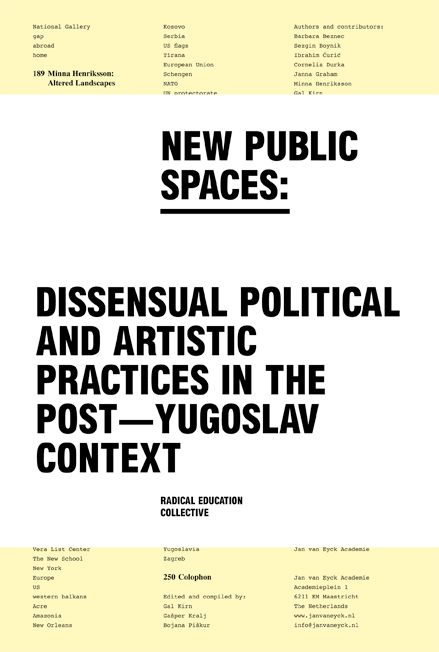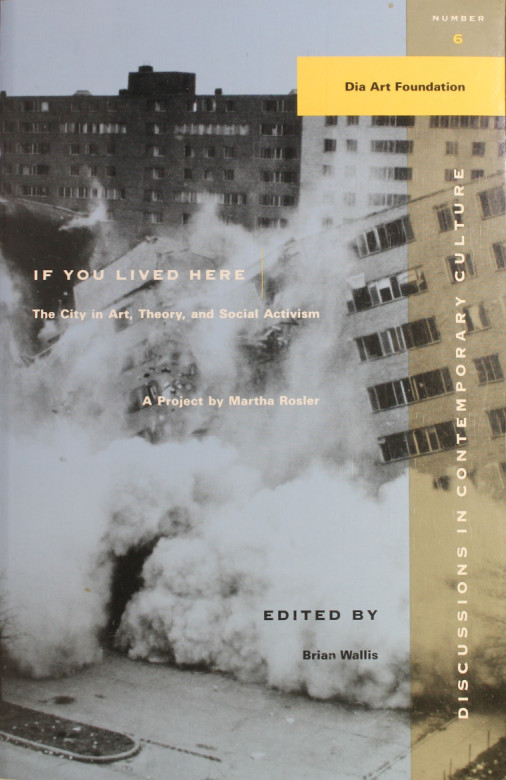Radical Education Collective (eds.): New Public Spaces: Dissensual Political and Artistic Practices in the Post-Yugoslav Context (2009)
Filed under book | Tags: · art, politics, public space, yugoslavia

“This reader draws its inspiration from encounters and conversations with activists, artists, critical thinkers, curators, militant researchers and writers from Belgrade, Helsinki, Istanbul, Ljubljana, London, Pristina and Prizren in April and May 2008 at the social centre ROG and the AKC Metelkova mesto in Ljubljana. Those encounters challenged not only the distinction between ‘serious’ discussions and ‘informal’ debates – that instantly reproduce linear time and hierarchical space – but also our mutual ability to listen, talk and share experiences (instead of consume information). Contributions were subsequently elaborated into the reader, which consists of two parts. In the first part, engaged collectives reflect on the organisation of different political issues: from anti-capitalist and student struggles, to immigrant workers and the re-appropriation of public spaces in the region. The second part focuses on specific art collectives from Kosovo and Ljubljana, which are occupied with the question of space: why was space so important when rethinking the relation between art and politics, and also what can one do with the space? Here, a set of political practices enabled art collective to undermine the presupposed liberal border between public and private. The reader concludes with a presentation of some art projects that intervened and articulated spatial and visual transformations in the post-Yugoslav context.”
Edited and compiled by Gal Kirn, Gašper Kralj, and Bojana Piškur
Publisher Jan van Eyck Academie, Maastricht, and Modern Galerija, Ljubljana, 2009
ISBN 9789072076878, 9072076877
194 pages
If You Lived Here: The City in Art, Theory, and Social Activism: A Project by Martha Rosler (1991)
Filed under book | Tags: · activism, art, city, gentrification, home, housing, new york, public space, theory

“This volume documents the present crisis in American urban housing policies and portrays how artists within the context of neighborhood organizations, have fought against government neglect, shortsighted housing policies and unfettered real estate speculation. Through essays, photographs, symposiums, architectural plans and the reproduction of works from the series of exhibitions organized by Martha Rosler, the book serves a number of functions: it’s a practical manual for community organizing; a history of housing and homelessness in New York City and around the country; and an outline of what a humane housing policy might encompass for the American city.” (from the back cover)
With contributions by Christine Benglia Bevington, Marie Annick Brown, Andrew Byard, Cenén, The Chinatown History Project, Clinton Coalition of Concern, Rosalyn Deutsche, Dan Graham and Robin Hurst, Alexander Kluge, The Mad Housers, Tony Masso, The Nation, Richard Plunz, William Price, Yvonne Rainer, Mel Rosenthal, Allan Sekula, Camilo José Vergara, and Dan Wiley.
Edited by Brian Wallis
First published by Bay Press, Seattle, and Dia Art Foundation, New York, 1991
First New Press printing, 1999
Discussions in Contemporary Culture series, 6
ISBN 156584498X, 9781565844988
x+312 pages
via Dubravka
Artist’s archive project, 2009
Artist
Publisher (New Press)
Publisher (Dia)
Exhibition
WorldCat
PDF (75 MB)
Comment (0)thresholds, 41: Revolution! (2013)
Filed under journal | Tags: · activism, architecture, archive, city, media, memory, politics, protest, public space, revolution, urbanism

“What actions are prompted by revolution in the space of the city? Which publics take part in this struggle, and who are the agents that mobilize it? And after a revolution has subsided, how is it remembered, represented and memorialized? thresholds 41: REVOLUTION! turns to the history, design, and cultural production of the public realm as a site of dissensus. Rather than focusing on a specific revolutionary time and place, we have strived to include different periods and regions, organizing contributions in terms of the relations they establish between sites, actors, and contexts. In the essays and designs featured in these pages, political struggle often shifts established roles—agitators create new types of public space, designers become activists and fundraisers, individual figures fade in favor of collectives or groups, and actions are best remembered through misrepresentation. How do we write revolution, who writes it and for whom? And, in turn, how does urban conflict inform writing, design, and cultural production at large? Our authors, designers, and artists open up revolution as subject, as event, and as historiographical problem—a problem complicated by discrete actions, multiple publics, critical practices, and the politics of display and remembrance.”
Contributors: David Gissen, Robin Adèle Greeley, Britt Eversole, Arindam Dutta, Diane E. Davis and Prassana Raman, Mark Jarzombek, Thérèse F. Tierney, Kenneth Ip, Nasser Rabbat, Reinhold Martin, Tunney Lee and Lawrence Vale, Andrés Jaque Architects + Office for Political Innovation, Santiago Cirugeda + Recetas Urbanas, Nomeda Urbonas and Gediminas Urbonas, The Yes Men, Ateya Khorakiwala, Simone Brott, Andrés Estefane, Kelly Presutti, Mechtild Widrich, Montenegro Airways
Edited by Ana María León
Publisher SA+P Press / MIT Department of Architecture, Cambridge, MA, Spring 2013
Open Access
ISSN 1091-711X
ISBN 9780983508267
212 pages
PDF (13 MB)
Comment (0)
